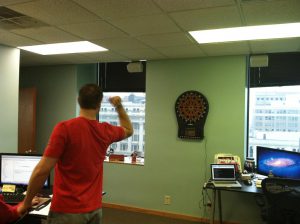15 is the new 21
It’s hard to get surprised anymore when you read about a young innovator who catapults to success via technology in the Mark Zuckerberg age. Spotify, Pinterest, Dropbox and Steelwool (yes I included Steelwool) come to mind. Young entrepreneurs helped introduce us to these innovations. This morning I read about British teen Nick D’Aloisio and shook my head. This one stands out.
A Great Idea
Nick is a 17 year old software wunderkind whose news reading app Summly excited Yahoo enough to purchase it (estimated tens of millions), hire Nick (he’ll break the Yahoo rules and work from home while testing out of the remainder of high school) and ideally for Yahoo, help resurrect their tarnished brand with a cutting edge tool. Summly is an app that takes long news stories and shortens them to the key points for smart phones. In the age of information and ADD, this idea comes at a perfect time. More information and less time to process that created the demand.
Nick is probably the youngest person to receive venture capital. One investor stated that he felt good about Nick’s idea when he ‘did not hesitate for a second when describing exactly what Summly was going to do.’ This speaks to the power of vision and coherence in ideas that can transcend age. Queue Aretha Franklin R-E-S-P-E-C-T…
Takeaways
This is a great story and it’s getting a lot of press. In April we’ll be writing a weekly piece on business lessons to be learned from the show Mad Men. Nick beat us to the punch. He is doing what he loves and perhaps has not had the experience of failure to cloud his vision and chip away at his confidence. To me this story is about ideas and the ability to execute on them.

Art Vs. Science
Working for Volano forces me to use a profoundly malnourished section of my brain (think Montgomery Burns from The Simpsons and what his heart looks like). This is the part of the brain that thinks in mechanical, linear terms where problems have solutions. It connects related items logically and utilizes facts and principles to construct solutions to problems. I live on the touchy-feely side of life. Metaphors, symbols, characters, emotions and of course, irony. For example, my keen awareness of the irony of writing about coding software. I’ll explain….
What is the Purpose of Good Software?
Before I tackle what has become an interesting metaphor for me in coding as a representation of the self, we should put coding in the context of software’s intent. Great software behaves the way a user thinks it should. You know what will happen if you do X. It’s intuitive, easy to use and simplifies processes and procedures. If you have an iPad and a 2 year old, you witness great software. My three year old can navigate Netflix on my smart phone, dial up Power Rangers and exempt me from the responsibility of raising him for yet another blissful afternoon. Behind this software is some pretty good code. What particularly interests me in good code are the adjectives people use to describe it. Elegant. Robust. Efficient. Complex. Defensive. Reusable. Correct. Intuitive. These words are both definitive and subjective. With some we could be describing wine or a painting. It made me wonder how coding to achieve an end could differ by programmer. How much does theory factor in and the personalities of software developers? See… English major BS.

What is Coding?
Coding, in computer systems, is the process of writing, assembling, and compiling computer code. It is the instructions for hardware and software. I asked my co-workers for their take on the degree to which coding has flexibility for personal touches, signatures. The responses varied, some of them unprintable lest Volano appear in an on-line search to the great disappointment of some amorous teenager. But we got some serious answers and analogies too.
“Making a lean-to of branches, building a skyscraper, writing software, and making a baby are similarly on a spectrum of expression of some pure form.” (Yikes… How does testing go for all of these?)
Others described writing code tailored to the client need. A developer we interviewed described the integrity of his code being known only to him because it did not break, but that it followed such a consistent structure that if someone did have to fix a system her built in the middle of the night, they could read his code, understand it and fix the problem in 5-10 minutes.
What Do You Think?
So I come back to square one. The developers at Volano are craftsman that delight in learning new tricks as much as they do in building disparate systems for our clients. They put something of themselves into their work to achieve an outcome for customers that renders their work invisible. It simply works as it was intended and is easy to use. Like the iPad and the 2 year old. What did these craftsmen/artists do 60 years ago? Design houses? Fix cars? Are we able to put our own signatures into our daily work?

“To succeed in sales, simply talk to lots of people every day. And here’s what’s exciting – there are lots of people!” – Jim Rohn
Much has been written about social media and the impact it’s had on branding and business networking. As a late adopter of social media but an old school disciple to the principles of relationship building, I’ve found interesting parallels between this relatively new medium (twitter, facebook, blogging) and the fundamental tenets of networking. I’ve also failed at times to apply those proven principles to our social media campaign and it has been a learning experience.
The Golden Rule
Whether your on-line or in a networking group, never lead with the hard pitch. Find out who you are talking to, what their interest and stakes are and see if you can help them achieve a goal, get a meeting with a prospect or land a client. This may entail spending some sweat equity on matters that don’t have an immediate payoff for you. However, one person at a time, you will have branded yourself as a collaborative partner. People like to work with partners, not pitchmen. In the social media world, this means that you should have something valuable to say. Be a subject matter expert and if possible, say it in a memorable way.
Bring Value
As my friend Cat (@Netlady29) says, social media will not make up for crappy service, crappy products or boring people. The ability to share thoughts with multitudes in seconds does not make up for shoddy service or products. Period. Building relationships is always made easier when the product you’re representing and the service that goes with it is consistent with your approach to relationships in the field.
Dialogue
Any salesperson will tell you that a face to face meeting beats the daylights out of a conference call or an e-mail chain. In the same respect, when someone bothers to comment on a blog post, you should acknowledge every comment. Validate those responses and learn from the comments you get. Perception is reality and the conversations sparked from a post can tell you what body language does when you’re across the table.
Personalize the Relationship
You don’t have to hold hands with your prospective customers while running down the beach (though if you achieve that level of intimacy I would wager to say that sale is a done deal). You should however bring your background and a little bit of yourself into the equation. People like to connect on levels beyond products and services. Where you are from, whether you have kids, what you studied in school and any idiosyncratic detail that makes you unique can help make you memorable. This is easy in person and more difficult through social media but should be kept in mind. @LikableMedia is a very interesting social media/marketing company. If you read the story of how they got started, it is hard not to get on board with their opportunistic social media savvy. The cliché ‘people buy from people’ is very true and although we have more avenues through which we can sell, one should now abandon the principles of building meaningful relationships and engaging people in a substantive way.
Those that follow Volano or have visited our office Downtown know that we take a little time out of each day to stretch, catch up on projects and play a competitive game of 301 (Darts). Whether you’re a client or simply a follower of Volano, it is important that you understand the line-up and style of each player. Guests are always welcome to join us and this breakdown might offer you a competitive advantage.
Rod “Cool Hand Luke” Smith.
Rod is one of the most consistent dart throwers and likes to hit the triple 19. He has a distinctive throwing style that consists of going through several practice throwing motions with his dart hand before releasing the dart. The level of concentration is admirable given the equal or not greater level of pure boobery taking place around him in an effort to get in his dome.
Don “Zero Gravity” Stavneak
Don is also a consistent leader in darts and has a unique throwing style that borrows heavily from The Matrix. For our younger readers, The Matrix was an academy award winning epic saga starring method actor Keanu Reeves, also known as the guy who plays the same character in every movie he’s ever been in and whose acting range consists of one emotion – dumbfounded. Don arches his body forward over the dart line of scrimmage at an angle that defies physics. While staying legal in his position, he is able to get 2-3 critical feet closer to the board without tipping and hits “bulls” and “double bulls” as often as many of us miss the board in its entirety.
Derek “Concussive Force” Jensen
Derek’s brute-force style of play belies his otherwise genteel demeanor. It’s been said of Derek that the terrible velocity of his throws (when they hit the board) can cause the dart board to confuse the math in its scorekeeping. Derek is as surprised as the rest of us when, on the off chance, his dart hits approximately where it is aimed. We keep our distance during his turns.
Brandon “Kids Get in the House” Moser
Brandon is quietly the most competitive of Volano dart players. Like Rod, he likes to aim for the 19 and frequently hits it. If he has a poor turn, you can count on the next one being 100 points. Brandon’s true competitive advantage is his confidence. The same cavalier disdain that he demonstrates toward personal hygiene can be seen in his tolerance for bad dart playing. His throwing style can most aptly be compared to the “Crane” kick popularized by Ralph Macchio in the Karate Kid series.
Jeremy “Ragin’ Cajun” O’Quin
Jeremy can never be underestimated at Darts. He will quietly outperform other Volano players and varies his throwing style wildly. Jeremy hails from Louisiana and is working on making his dart proficiency equal to his amazing cooking skills.
Kelly “Broken Darts” Grace
Kelly has a wildly inconsistent throwing method which makes him an X factor in every game. He will show moments of incomprehensible raw talent, hitting three tripe scores in a turn and will follow that round with two bovine misses and a three. It is accepted* that Kelly’s darts are likely not in proper working order, causing these issues. His throwing style has been compared to a toddler having a temper tantrum.
*accepted only by Kelly
David “Math Skills” Carnley
David is a frequent contender for the daily dart trophy but his dart style of play is overshadowed by the quickness with which he can calculate where he needs to throw darts to reach the desired score necessary for him to overtake a winner by finishing 301 with a bulls-eye or positioning himself for an iron-clad win. David likes to have his K-Mart underwear when he plays and will not miss The People Court when it comes on after Darts.
Shane “The Clown” Fitch
Shane Fitch is a fine player. His throwing style is not remarkable, however he likes to make remarks while others are throwing, often waiting for the perfect moment to crack wise and throw a player out of rhythm. Psy-Ops is his differentiator. Shane does impressions and is quick with a joke, often sang in rhyme of as an impression. A highly dangerous player.
We have three developers that work remotely, Jeremy, Luis and Harry. They make up strong bench strength for Volano and are always factors.

Software Developer Internship Opportunity
Volano Solutions is a young, dynamic software consultancy located in downtown Omaha. We build custom software for businesses in the metro area and have grown consistently over 5 years. We foster a very collaborative, fun culture and are constantly learning. The company was founded and run by software developers who are passionate about their code and encourage camaraderie and professional development. We are looking for a smart, hard-working individual interested in learning and applying their software experience.
The Work
Your primary project will be building a SaaS based web app from the ground up. You will have assistance from other people at Volano including one of the owners and our resident Photoshop and image (html/css) expert, taking this project from concept to market (or as close as you can, based on your timeframe). You will do most of the coding with full mentorship. Additionally, we will look to you to see what other experience you’d like to gain while working with us. This could include marketing, sales, webinars, demo videos, blogging, social media or other areas you’re interested in that align with our company vision. The internship pays $14 per hour and you can expect between 36-40 hours per week. The estimated timeline on this project is between 300- 400 hours.
Relevant Applications and Platforms
- ASP.NET MVC 4 framework using C#
- SQL Server 2008R2 or 2012
- Entity Framework
- jQuery
- Telerik controls
- Authorize.NET for the payment gateway
If interested, e-mail Kelly Grace at [email protected] or call 402-934-3733. We’d be happy to answer any questions that you have and set up an interview if the opportunity looks like a good fit.
Check us out at volanosoftware.com or on Facebook at www.facebook.com/VolanoSolutions/

“Take it from me, there’s nothing like a job well done. Except the quiet enveloping darkness at the bottom of a bottle of Jim Beam after a job done any way at all.”
― Hunter S. Thompson, Fear and Loathing in Las Vegas
Back to Work
Recently Yahoo CEO Marissa Mayer, under likely pressure from the Board of Directors issued a referendum on employees working from home. This change has caused an understandable stir among employees who have grown accustomed to doing their jobs remotely, many of whom argue that they get more done by avoiding the bother and distraction of other employees.
Yahoo!
I think in the position Yahoo is in, they need to make significant changes. Some of them won’t be popular but losing market share and failing to capitalize on that iconic brand does not a winning business model make. Volano does a good job of respecting work-life balance and understands that happy employees produce. But this is always a tough and blurry line. When is face to face better than skype? How critical is body language and the old-fashioned creaking of a turning chair to e-mail? Are inappropriate jokes better in person?
What Do You Think?
We’re interested in your thoughts dear readers. All 5 of you. Let us know what you think about requiring people work in an office. Or you can tell us when we get home from work too. Do ergonomically correct chairs factor into this discussion? Do certain types of jobs require physical presence? An airplane pilot for example or a Hollywood tour guide for the stars would be challenged performing their duties from the creature comforts of home? Maybe not. I am of the belief that presence matters, thought it may not always be possible.
Volano creates business software centering around workflow. We also consult with our customers about their business processes. From time to time, we get the question – what processes should we automate? This article speaks to that question directly:
“[Track] employee time to determine if employees are spending large amounts of time on processes that can be easily automated. In cases such as these, implementing an automated system often provides a high return on investment by decreasing time spent on tedious activities while freeing employees to work on other tasks.”
An example of this – one of our clients was responsible for creating highly sensitive, data driven personalized emails. Each email had a secure zip attachment that would contain any prescribed number of over 15 forms that had to be personally addressed, populated with unique information, and contained data driven tables. It would have been near impossible to create these manually – not to mention the turn-around-time was measured in hours.
In this case, the need for accuracy and speed demanded automation.
Care and feeding
The article also points out that modern systems need “regular monitoring and updates.” We couldn’t agree more. A friend of mine named Charlie Crabb coined a term for this. He calls it “care and feeding.” As your business changes, your business processes change; and your systems must change too. These changes can cause downstream processes to break – therefore monitoring and updates are a necessity.
Obviously this requires budget. The alternative is to be rigid and stagnant and resist the change process; in the short run this is less expensive. However we often find that stagnant business are soon left behind by their more progressive counterparts.